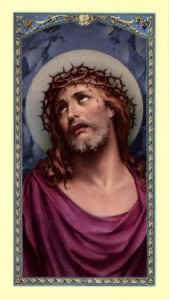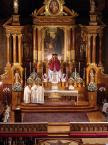
+JMJ+
To Jesus Christ, our Sov'reign KingTo Jesus Christ, our Sov'reign King,
Who is the world's salvation,
All praise and homage do we bring,
And thanks and adoration.
Refrain:
Christ Jesus Victor, Christ Jesus Ruler!
Christ Jesus, Lord and Redeemer!
2. Thy reign extend, O King benign,
To ev'ry land and nation,
For in Thy kingdom, Lord divine,
Alone we find salvation.
(Refrain)
3. To Thee and to Thy Church, great King,
We pledge our hearts' oblation,
Until before Thy throne we sing,
In endless jubilation.
(Refrain)
The King of GloryRefrain
The King of glory comes,
the nation rejoices.
Open the gates before him,
lift up your voices.
1. Who is the King of glory;
how shall we call him?
He is Emmanuel,
the promised of ages.
2. In all of Galilee,
in city or village,
He goes among his people
curing their illness.
3. Sing then of David’s Son,

our Savior and brother;
In all of Galilee
was never another.
4. He gave his life for us,
the pledge of salvation,
He took upon himself
the sins of the nation.
5. He conquered sin and death;
he truly has risen,
And he will share with us
his heavenly vision.
Text: 12 12 with refrain. Text © 1967, William F. Jabusch. Administered by OCP. All rights reserved. Music: Trad. Israeli Folk Song.
Crown Him with Many CrownsCrown Him with many crowns, the Lamb upon His throne.
Hark! How the heavenly anthem drowns all music but its own.
Awake, my soul, and sing of Him who died for thee,
And hail Him as thy matchless King through all eternity.
Crown Him the virgin’s Son, the God incarnate born,
Whose arm those crimson trophies won which now His brow adorn;
Fruit of the mystic rose, as of that rose the stem;
The root whence mercy ever flows, the Babe of Bethlehem.
Crown Him the Son of God, before the worlds began,
And ye who tread where He hath trod, crown Him the Son of Man;
Who every grief hath known that wrings the human breast,
And takes and bears them for His own, that all in Him may rest.
Crown Him the Lord of life, who triumphed over the grave,
And rose victorious in the strife for those He came to save.
His glories now we sing, who died, and rose on high,
Who died eternal life to bring, and lives that death may die.
Crown Him the Lord of peace, whose power a scepter sways
From pole to pole, that wars may cease, and all be prayer and praise.
His reign shall know no end, and round His piercèd feet
Fair flowers of paradise extend their fragrance ever sweet.
Crown Him the Lord of love, behold His hands and side,
Those wounds, yet visible above, in beauty glorified.
No angel in the sky can fully bear that sight,
But downward bends his burning eye at mysteries so bright.
Crown Him the Lord of Heaven, enthroned in worlds above,
Crown Him the King to Whom is given the wondrous name of Love.
Crown Him with many crowns, as thrones before Him fall;
Crown Him, ye kings, with many crowns, for He is King of all.
Crown Him the Lord of lords, who over all doth reign,
Who once on earth, the incarnate Word, for ransomed sinners slain,
Now lives in realms of light, where saints with angels sing
Their songs before Him day and night, their God, Redeemer, King.
Crown Him the Lord of years, the Potentate of time,
Creator of the rolling spheres, ineffably sublime.
All hail, Redeemer, hail! For Thou has died for me;
Thy praise and glory shall not fail throughout eternity.
 The King of Love My Shepherd Is
The King of Love My Shepherd IsThe King of love my Shepherd is,
Whose goodness faileth never,
I nothing lack if I am His
And He is mine forever.
Where streams of living water flow
My ransomed soul He leadeth,
And where the verdant pastures grow,
With food celestial feedeth.
Perverse and foolish oft I strayed,
But yet in love He sought me,
And on His shoulder gently laid,
And home, rejoicing, brought me.
In death’s dark vale I fear no ill
With Thee, dear Lord, beside me;
Thy rod and staff my comfort still,
Thy cross before to guide me.
Thou spread’st a table in my sight;
Thy unction grace bestoweth;
And O what transport of delight
From Thy pure chalice floweth!
And so through all the length of days
Thy goodness faileth never;
Good Shepherd, may I sing Thy praise
Within Thy house forever.
 +JMJ+
+JMJ+
















